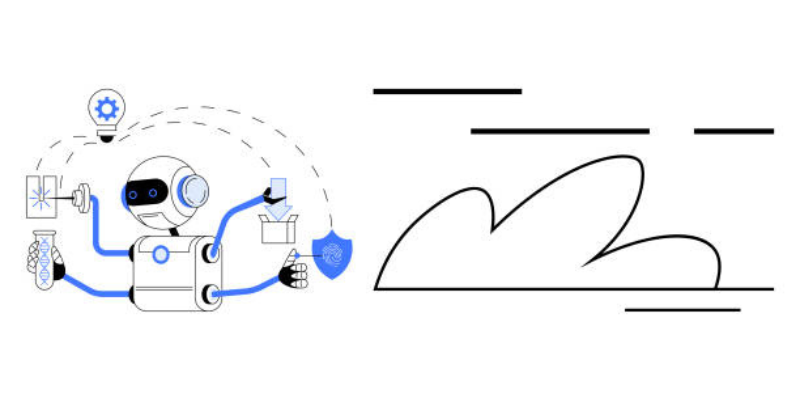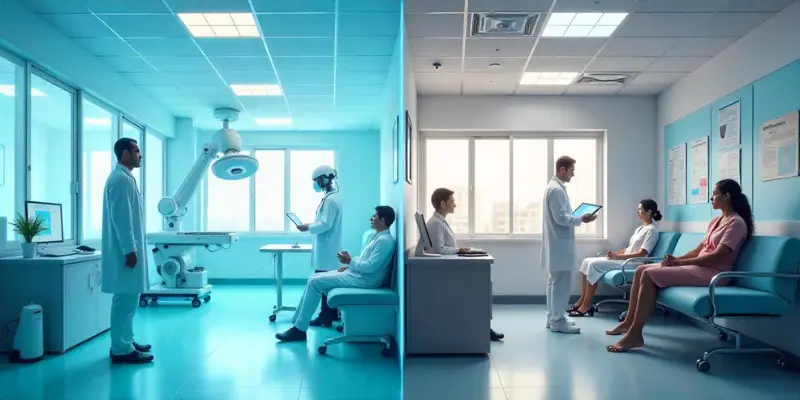How AI Automation is Updating the Healthcare by Lowering the Overhead Burden
Published: 20 Mar 2025
Long wait times, endless paperwork and diagnostic delays frustrate both patients and healthcare professionals. AI automation in healthcare promises to solve these issues by streamlining hospital operations, speeding up test results and even personalizing patient care. But is your hospital or clinic ready to embrace AI for better efficiency?

In the previous article we discussed how AI is making changes in healthcare administration. In this article we are going to explore specifically AI automation in the healthcare sector. Let’s start with the definition of AI automation.
What is AI Automation?
Imagine a hospital as a busy restaurant. Doctors and nurses are the chefs, preparing and serving life-saving treatments. But what if they also had to take orders, clean tables and manage the cash register? It would slow everything down.
Now, AI automation is like a smart kitchen assistant that handles repetitive tasks—taking orders, tracking ingredients and even suggesting recipes—so the chefs can focus on cooking. In healthcare, AI does the same by handling paperwork, scheduling and analyzing medical data, allowing doctors to focus on patients.
AI automation in healthcare refers to the use of artificial intelligence and machine learning to streamline hospital workflows, improve diagnostics and enhance patient care. It helps with administrative tasks, medical imaging, robotic surgeries and virtual assistants, reducing workload and improving efficiency.
Importance of AI Automation in Healthcare
AI automation in healthcare is essential because it enhances efficiency, accuracy and patient care. It reduces the burden of repetitive tasks like scheduling, billing and medical data entry which allows doctors and nurses to focus more on treating patients. AI-powered diagnostics help detect diseases earlier and more accurately, leading to better treatment outcomes.
AI Robotic-assisted surgeries improve precision and reduce risks and recovery time. Virtual assistants and AI chatbots provide instant support, making healthcare more accessible. By automating routine processes, AI not only saves costs and time but also ensures faster, smarter and more effective healthcare services.
How AI Automation in Healthcare Works
AI automation in healthcare processes medical data, learns from patterns and performs tasks to improve efficiency. It works in different areas:

- Data Collection & Processing– AI scans medical records, lab reports and imaging results to extract useful information.
- Pattern Recognition– AI-powered tools analyze past cases to detect diseases earlier and suggest treatments.
- Task Automation– AI automates repetitive tasks like scheduling, billing and patient documentation.
- Virtual Assistance– AI chatbots answer health-related questions, schedule appointments and remind patients about medications without needing nurses.
- Robotic Assistance– AI-powered robotic systems help in surgeries and ensure precision and minimizing errors.
Common Misconceptions About AI Automation in Healthcare
🔹 Misconception 1: AI Replaces Doctors
✅ Reality: AI does not replace doctors; it supports them by handling routine tasks and allowing them to focus on patient care.
🔹 Misconception 2: AI is 100% Accurate
✅ Reality: AI improves accuracy but is not perfect. It requires human supervision to avoid errors.
🔹 Misconception 3: AI Can Diagnose Patients Without Doctors
✅ Reality: AI provides decision support by analyzing medical data but final diagnoses and treatments are made by doctors.
🔹 Misconception 4: AI in Healthcare is Unsafe
✅ Reality: AI follows strict privacy laws (HIPAA, GDPR) and security measures to protect patient data.
AI automation enhances healthcare by making it faster and more efficient but human expertise remains irreplaceable.
What Could Go Wrong with AI Automation in Healthcare (And How to Fix It)
While AI automation improves healthcare, it’s not perfect. Here are some common problems with AI automation and their solutions:
1. Misdiagnosis or Errors in AI Predictions
🔴 Problem: AI models can misinterpret medical data, leading to incorrect diagnoses or treatment suggestions.
✅ Solution: Doctors should validate carefully the AI-generated results before making clinical decisions. AI systems must be continuously trained with diverse and high-quality medical data to improve accuracy.
2. Data Privacy & Security Risks
🔴 Problem: AI systems process sensitive patient data which makes them a target for cyber threats.
✅ Solution: Hospitals should use strong encryption, multi-layer security protocols and comply with laws like HIPAA & GDPR to protect patient data.
3. Bias in AI Algorithms
🔴 Problem: If AI is trained on limited or biased data, it may not provide accurate results for different groups.
✅ Solution: AI models should be trained on diverse and representative datasets to ensure fairness in healthcare decisions.
4. High Costs of AI Implementation
🔴 Problem: AI-powered automation requires expensive software, infrastructure and staff training.
✅ Solution: Governments, investors and AI focused healthcare providers should come together and invest in scalable AI solutions and offer training programs to integrate AI smoothly into medical workflows.
Also Read: AI Implementation in Healthcare
5. Resistance from Healthcare Professionals
🔴 Problem: Some doctors and staff fear AI might replace their jobs or add complexity to their work.
✅ Solution: Educating healthcare professionals about AI’s role as a supportive tool can help them adopt it with confidence.
Do you want to learn about How AI is is automating the hospital tasks with real time insights? Read this article Real-Life examples of AI Automation in Healthcare.
Types of AI Automation in Healthcare
AI automation in healthcare comes in different forms and each is designed to improve efficiency and patient care. Here are the key types:
🔹 Administrative AI– Automates scheduling, billing and patient records management.
🔹 Diagnostic AI– Helps in detecting diseases through medical imaging and lab data analysis.
🔹 Predictive AI– Analyzes patient history to forecast potential health risks.
🔹 Robotic AI– Assists in surgeries and physical rehabilitation with precision robotics.
🔹 Virtual Health Assistants– AI chatbots and voice assistants guide patients and answer medical queries.
🔹 Pharmaceutical AI– Accelerates drug discovery and development by analyzing complex data.
Each type plays a crucial role in streamlining healthcare operations and enhancing patient outcomes.
Is AI automation a threat to Nurses? Find out in this article: Will AI Replace Nurses
AI Automation in Healthcare: Developed vs. Developing Countries
AI automation is transforming healthcare worldwide but its application varies based on a country’s resources, infrastructure and healthcare needs.

1. In Developed Countries
💡 Focus: Precision medicine, advanced robotics and data-driven healthcare.
🔹 AI-Powered Diagnostics: Hospitals use AI for early disease detection through advanced imaging and predictive analytics.
🔹 Robotic-Assisted Surgeries: AI-powered robots assist surgeons in complex procedures and improve precision.
🔹 AI-Driven Drug Discovery: AI speeds up drug research and personalized treatments for diseases like cancer.
🔹 Smart Hospital Management: AI automates patient scheduling, billing and administrative tasks, reducing workload.
🚀 Example: The U.S. and the U.K. use AI for real-time patient monitoring, AI-driven clinical trials and robotic surgery in top hospitals.
Related Article to Read: How to Boost Your Healthcare AI Career
2. In Developing Countries
💡 Focus: Expanding healthcare access, reducing costs and addressing resource shortages.
🔹 AI Chatbots for Telemedicine: AI-powered chatbots provide basic consultations where doctors are scarce.
🔹 Low-Cost AI Diagnostics: Mobile-based AI tools analyze X-rays and blood samples, detecting diseases affordably.
🔹 AI for Epidemic Prediction: AI tracks disease outbreaks and helps governments plan responses.
🔹 AI-Powered Medical Translations: AI translates medical advice into local languages, improving accessibility.
🌍 Example: India and Africa use AI-powered mobile apps for disease diagnosis and AI chatbots help provide basic healthcare advice in remote areas.
Key Differences
| Feature | Developed Countries | Developing Countries |
| Primary Goal | Precision & efficiency | Accessibility & affordability |
| AI in Diagnostics | Advanced imaging & genetic AI | Mobile AI tools for basic screening |
| AI in Surgery | Robotic-assisted surgeries | Limited due to cost & infrastructure |
| AI in Patient Care | Smart hospital automation | AI chatbots for rural healthcare |
AI automation enhances healthcare in both settings but its focus shifts based on available resources and challenges.
Also Read: AI Case Studies in Healthcare which covers real world examples of AI’s role in healthcare.
Advantages and Disadvantages of AI Automation in Healthcare
AI automation is transforming healthcare by improving efficiency, accuracy and patient care. However, it also has disadvantages that need to be addressed.
| ✅ Advantages |
|---|
|
| ❌ Disadvantages |
|---|
|
Article to Read: Should AI bed used in Healthcare?
Conclusion
AI automation in healthcare is bringing enormous changes in terms of patient care by making medical processes faster, smarter and more efficient. While challenges exist, the benefits far outweigh the risks when AI is used responsibly. The future of healthcare is driven by innovation and AI is at its core.
🚀 Now is the time to explore AI automation in healthcare, embrace its potential and be part of a smarter and healthier world!
FAQs on AI Automation in Healthcare
Here are frequently asked questions about AI automation in healthcare;
No, AI is designed to assist, not replace healthcare professionals. It automates routine tasks and allows doctors to focus on patient care.
AI can detect diseases with high accuracy, but it’s not perfect. It works best as a decision-support tool alongside human doctors.
Yes, when properly regulated. AI tools follow strict security and privacy laws (HIPAA, GDPR) to protect patient data.
Yes, if trained on limited or biased data. Ensuring diverse datasets and human oversight helps in preventing biased AI results.
Advanced AI systems can be costly, but cost-effective AI solutions like chatbots and telemedicine tools are improving accessibility.
No, AI chatbots provide basic support and information but real doctors are needed for medical diagnosis and treatment.
By starting with simple AI tools like automated scheduling, AI diagnostics or virtual assistants and then scaling to advance based on needs and budget.





